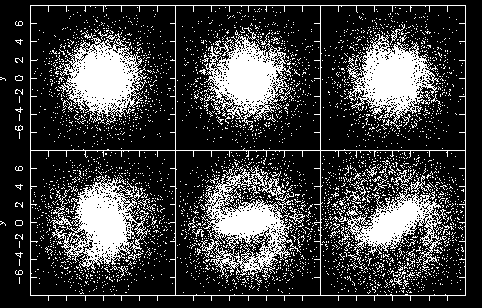NEMO is a toolbox for stellar dynamics, particle simulations, stellar orbits, image processing and tabular data manipulation. Documentation is maintained in the github pages, https://teuben.github.io/nemo
This is the 4th major release of NEMO, and although data are compatible with earlier releases, old source code may need to be tweaked a bit to compile and link in the newer releases. Some compatibility with ZENO is also advertised. A brief history of NEMO:
- NEMO V1: IAS release (Barnes, Hut & Teuben, 1987)
- NEMO V2: UMD release (Teuben, 1994)
- NEMO V3: UMD release (Teuben, 2001) in CVS, with autoconf support and hooks into manybody.org modules starlab and partiview
- NEMO V4: UMD/ESO release (2017) now maintained in github
A related package, ZENO, was spun off NEMO V1, and is maintained by Josh Barnes. Other packages that geneologically came after NEMO are StarLab, ACS and AMUSE (see also https://ascl.net for code references):
NEMO: ascl:1010.051
ZENO: ascl:1102.027 (normally installed in $NEMO/usr/zeno)
STARLAB: ascl:1010.076
ACS: https://artcompsci.org
AMUSE: ascl:1107.007
Packages we optionally use (sometimes also installed in $NEMO/opt with source code in $NEMO/local):
PGPLOT: ascl:1103.002
CFITSIO: ascl:1010.001
WCSLIB: ascl:1108.003
glnemo2: ascl:1110.008
gyrfalcON: ascl:1402.031 (included with NEMO)
HDF4
HDF5 https://www.hdfgroup.org
netcdf4
gsl
plplot
unsio
uns_project
wcstools
Tools you will need to have pre-installed: the C/C++/Fortran compilers, (t)csh, and git. For graphics it's probably useful to have pgplot, but the default ps driver works fine just to get started quickly.
The files in $NEMO/src/scripts/linux describe the actual package names for different linux distros that should lead to success.
There are a few different ways to install NEMO, here is a basic example that works most of the time on most Linux distros (assuming you have the preconditions):
git clone https://github.com/teuben/nemo
cd nemo
./configure --with-yapp=pgplot
make build check bench5
source nemo_start.sh
If you plan to modify code and submit pull request, the github CLI is now recommended, though you can of course also clone the upstream manually (see also CONTRIBUTING.md):
gh repo fork https://github.com/teuben/nemo
On the most recent apple controlled hardware, with SIP enabled, you're in for a rude awakening. I use brew, and assuming you have gcc-10 (and related) and pgplot installed, this should work (there may be other ways to install tools on a mac, but don't get me started):
git clone https://github.com/teuben/nemo
cd nemo
CC=gcc-10 CXX=g++-10 F77=gfortran-10 ./configure --disable-shared --with-yapp=pgplot
make build check bench5
source nemo_start.sh
After installaton, rebuilding NEMO to ensure you have all updates can be done as follows:
cd $NEMO
git pull
make rebuild
There is now a small python component to NEMO, in the nemopy module.
cd $NEMO
pip install -e .
but this will depend on the details of how your python environment exists (virtual, conda etc.). We leave this to the user.
If you want to quickly see something work, here are the commands to make a classic 1911 Plummer sphere of just 10 particles, print the positions, plot the positions and view the contents of its binary file:
mkplummer p10.dat 10
snapprint p10.dat
snapplot p10.dat
tsf p10.dat
and here is an example of creating the 4 major data objects on the fly in NEMO (table, snapshot, image, orbit), showing off the command line interface and use of unix pipes with a dash denoting the piped file:
tabgen - | tabplot -
mkplummer - 100 | snapplot -
ccdgen out=- object=gauss spar=1,20 size=128 | ccdplot -
mkorbit - 0 1 0 0.4 0 0 potname=plummer | orbint - - nsteps=1000 dt=0.05 | orbplot -
There are more examples of scripts and figures in https://teuben.github.io/nemo/examples/ and an example ipython notebook is shown here https://github.com/teuben/nemo/blob/master/nemo_start_example.ipynb for something completely different.
There are several additional entry points if you are starting out with NEMO:
- readthedocs: https://astronemo.readthedocs.io/en/latest/
- github pages: https://teuben.github.io/nemo
- software carpentry: https://teuben.github.io/nemo-lesson
- contributing to NEMO: CONTRIBUTING.md
Please use the following citation if you use NEMO in your work
@INPROCEEDINGS{1995ASPC...77..398T,
author = {{Teuben}, P.},
title = "{The Stellar Dynamics Toolbox NEMO}",
booktitle = {Astronomical Data Analysis Software and Systems IV},
year = 1995,
editor = {{Shaw}, R.~A. and {Payne}, H.~E. and {Hayes}, J.~J.~E.},
series = {Astronomical Society of the Pacific Conference Series},
volume = {77},
month = jan,
pages = {398},
adsurl = {https://ui.adsabs.harvard.edu/abs/1995ASPC...77..398T},
adsnote = {Provided by the SAO/NASA Astrophysics Data System}
}
